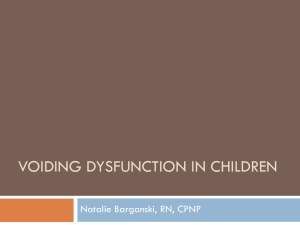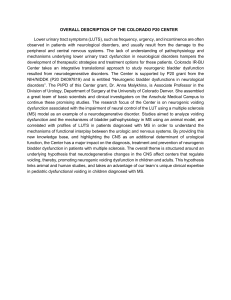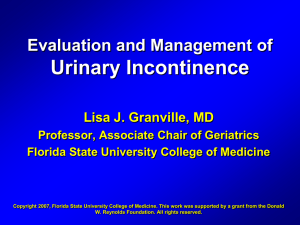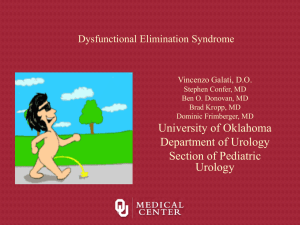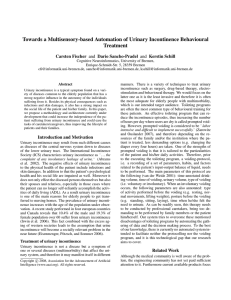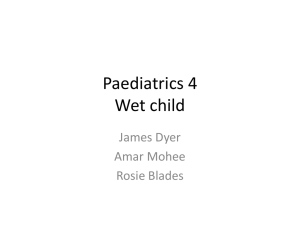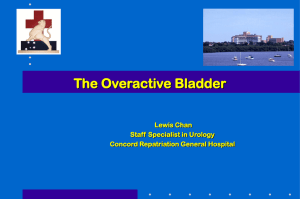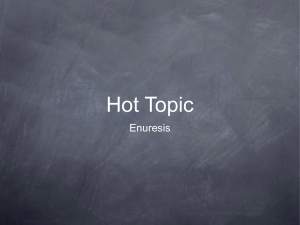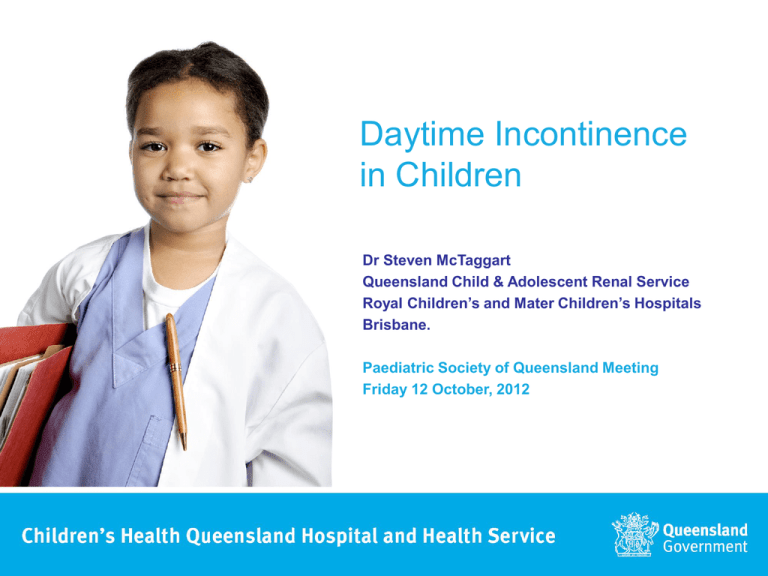
Daytime Incontinence
in Children
Dr Steven McTaggart
Queensland Child & Adolescent Renal Service
Royal Children’s and Mater Children’s Hospitals
Brisbane.
Paediatric Society of Queensland Meeting
Friday 12 October, 2012
Children rated wetting themselves at school
as the third most catastrophic event behind
losing a parent and going blind.
Ollendick et al, Behav Res Therapy, 1989.
?A Mental Illness
Enuresis – DSM V
• Repeated voiding of urine into bed or clothes (whether involuntary or
intentional).
• The behaviour is clinically significant as manifested by either a frequency of
twice a week for at least 3 consecutive months or the presence of
clinically significant distress or impairment in social, academic
(occupational), or other important areas of functioning.
• Chronological age is at least 5 years (or equivalent developmental level).
• The behaviour is not due exclusively to the direct physiological effect of a
substance (e.g., a diuretic or an antipsychotic medication) or another
medical condition (e.g., diabetes, spina bifida, a seizure disorder).
Outcomes
Vemulakonda VM and Jones EA (2006) Nat Clin Pract Urol 3: 551–559
International
Childrens
Continence Society
Classification (2006)
Case Study
• 10 year old girl - Referred from GE Clinic
› Long-standing patient of regional paediatrician
› Chronic constipation
- multiple investigations and treatment incl 4
previous admissions for washout
› Daytime incontinence and nocturnal enuresis
Evaluation - History
• Age and pattern of toilet training
› longest dry periods - primary vs secondary
- Toilet trained 2 years age
- Dry during day for 2 months - never been dry since then
- Wets daily – never dry at night
• Current symptoms and signs
› voiding pattern - stream/volume/frequency/post-void
dribbling
- Wears pad during the day – always damp but rarely soaks
through to clothes
- Frequent voiding – up to 8x/day at school – ?small vols
- No post-void dribbling
- Not continuously wet
→ Consider Voiding Diary
Voiding Diary
(http://childrenshospital.org/clinicalservices/Site2852/Documents/voidind_diary.pdf)
Voiding Diary App
Ectopic Ureter
Evaluation - History
› urgency / holding manoeuvres
› perineal hygiene - vulvovaginitis/balanitis
› dysuria / frequency / UTI’s
- Previously recurrent UTI – none for 3 years
Evaluation - History
› CONSTIPATION
- Constipation with soiling since 2 years age
- Multiple unsuccessful treatments
- Does not use school toilets
- ‘withholding’ behaviour
• Family history of urological problems
- Nil
• Developmental / behavioural issues
• Social history - think about CSA
Evaluation - Physical Exam
• Exclude structural lesions
› Abdominal examination
› Genital examination
- labial adhesions/meatal stenosis
- bifid clitoris
• Exclude occult neurological disorders
› examine back for signs of occult spina bifida
› DTR’s lower limbs
› gait
› ?anal wink
Evaluation - Investigations
•
Urinalysis - dipstick, M/C/S, (urine osmolality)
•
Ultrasound
› estimate functional bladder capacity & residual
• IVP/CT urogram if suspect ectopic ureter
•
MCU
› if abnormal USS esp trabeculation/thickened bladder wall
•
Spinal imaging – not routine
•
Urodynamics – not routine
Evaluation - Role of Spinal Imaging
Wraige E & Borzyskowski M, Arch Dis Child, 2002
- retrospective study - 48 children with voiding dysfunction
- closed spina bifida present in 5 patients - only 1 had no cutaneous,
neuro-orthopaedic or lumbosacral spine abnormalities.
Nejat et al, Pediatr 2008
- 176 children with encoporesis/enuresis - 88 with SBO and 88 control
- 17 (38%) bony spina bifida occulta
- 10/48 underwent MRI - 1 had lipoma requiring resection
Recommendations for Spinal Imaging
• neurological /neuro-orthopaedic abnormality
• secondary enuresis or deterioration in primary enuresis
• significant associated bowel abnormality
• urodynamic study suggesting neurogenic bladder
Evaluation - Urodynamic Studies
• Not required for majority of children
• Indicated if;
› evidence of/at risk of upper tract deterioration
- hydroureteronephrosis
- high grade VUR
- recurrent episodes of pyelonephritis
› suspicion or evidence of neurological abnormality
› ?significant daytime enuresis that fails to respond to
conventional treatment
› (unexplained secondary enuresis - cystoscopy is preferable)
Diagnosis – Functional Voiding Disorders
Stress
Incontinence
Underactive
bladder
Voiding
postponement /
“holding”
Urge syndrome
Dysfunctional
voiding
Extreme
Daytime
Frequency
General Principles of Treatment
Constipation
Voiding
Pattern
Urotherapy
Pharmacological
Management
• Urotherapy
› Timed voiding, posture, avoiding holding
› Lifestyle – fluid intake
› Biofeedback / physiotherapy
• Pharmacological
› Anticholinergics
- oxybutinin tabs / patches (Ditropan™)
- tolteridine (Detrusitol™)
- solenifacin (Vesicare™)
› (Tricyclic antidepressants)
› ? prazosin / ? ddAVP (Minirin™)
Bladder Retraining
“Bad” bladder behaviour
Imbalance in “inhibiting” and “initiating” voiding
Pharmacological Management
Management
• Urotherapy
› Timed voiding, posture, avoiding holding
› Lifestyle – fluid intake
› Biofeedback / physiotherapy
• Pharmacological
› Anticholinergics
- oxybutinin tabs / patches (Ditropan™)
- tolteridine (Detrusitol™)
- solenifacin (Vesicare™)
› (Tricyclic antidepressants)
› ? prazosin / ? ddAVP (Minirin™)
? combination
therapy
Outcomes
Vemulakonda VM and Jones EA (2006) Nat Clin Pract Urol 3: 551–559
Long Term Outcome
Kuh et al, 1999.
› Longitudinal study of 1333 women with urinary incontinence (mean
age 48 years)
› 50% reported stress incontinence
› 22% reported urge incontinence
› 8% had severe symptoms
› Women who had daytime wetting as a child were more
likely to have severe symptoms
The End

